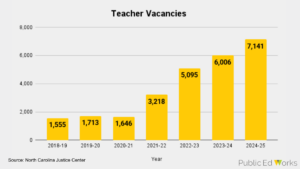By Amy Cockerham
Public Ed Works
RALEIGH (September 17, 2025) – Thousands of teachers leave North Carolina classrooms every year – and legislators ignoring the needs of educators could be to blame.
Low pay and lack of respect, among other problems, are cited as reasons why school districts have trouble filling teaching positions.
The latest attrition rate, or what percentage of teachers left their jobs in a public school, was 9.88% for 2023-24.
Unfilled positions have grown each year, according to the NC Department of Public Instruction.
Erin Horne is the College of Education Assistant Dean for Professional Education and Accreditation at NC State University.
“A lot of times people want to be educators, but sometimes the narrative and the stories that are around them kind of talk them out of it,” Horne said.
A lack of proper funds for support staff such as teacher assistants, nurses and school counselors is another concern for today’s educators.
About 800 fewer people completed educator preparation programs in 2024 than in the prior year, an 18% decline, data from the Department of Public Instruction shows.
Horne said NC State has actually seen an increase in candidates after ramping up recruitment efforts.
“Over the past couple of years we’ve increased our scholarship moneys for students,” Horne said. “So that increases their opportunity to leave, to graduate, with as little debt as possible.”
Financial aid is important for students considering a career in teaching – the latest report from the National Education Association ranked North Carolina 43rd in the U.S. for average teacher pay.
North Carolina public schools also have a hard time attracting teachers of color. In the 2023-2024 school year, 57.2% of North Carolina’s public school students identified as students of color, while only 29.4% of the state’s educators were nonwhite.
Gerrelyn Patterson is the Department of Education Preparation Chair at N.C. A&T State University. A&T has seen low enrollment in teacher-prep programs as well.
“We have experienced those same statistics as other educator-prep programs,” Patterson said. “But we do see a slight increase that we think some of our recruitment efforts have played a major part in.”
She said program leaders are trying everything from speaking to current students to bringing high school students to campus to learn about becoming an educator.
“We need lawmakers who are going to listen to the realities of what it means to be in the profession,” Patterson said. “What some of those joys and wonderful things are about the profession, and what challenges or barriers may be in place that lawmakers have jurisdiction over.”
Local school systems cope with vacancies by hiring international teachers and non-traditional path teachers.
“Every week, almost every day, I get an email from someone who’s looking to hire an A&T future teacher, Patterson said.
Temporarily licensed teachers make up 10% of North Carolina’s teacher workforce. But many of them leave because they find it difficult to meet the requirements to earn a full teaching license which is required to teach for longer than three years.
Looking ahead, a step in the right direction may come if the budget advanced by the NC House is passed, as it would take steps to significantly raise teacher pay in the state.
“It’s kind of a cliché to say, but teachers make all the other careers happen,” Horne said. “When you make connections with children and can change the trajectory of their lives as an educator, there’s no greater reward.”
This is the latest installment of our “Lessons Learned” series aiming to address how legislative actions – and inaction – in North Carolina over the past few decades have contributed to harm in our public schools. For a chronicle of our previous work, click here.



Leave a Reply